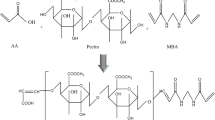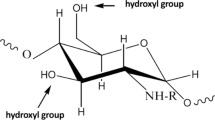Abstract
For effective treatment of various diseases, pharmaceutical world require smart drug delivery systems in order to improve bioavailability, bio-degradability, site specific delivery and controlled release of drug. For this purpose, stimuli-responsive hydrogel comprised of polysaccharides chitosan and pectin, synthetic polymer polyvinylalcohol (PVA) and environment friendly coupling agent 3-aminopropyl (diethoxy)methylsilane (3-APDEMS) was fabricated. These polymers were blended and crosslinked with varying amount of crosslinker via solution casting technique. FTIR characterization elucidated the presence of chitosan, pectin and PVA functional groups as well as newly developed chemical and physical bondings. TGA showed increase in thermal stability with increase in the concentration of crosslinker. Swelling analysis depicted the successful crosslinking of polymeric chains as the swelling decreased with increase in crosslinker concentration. The change in swelling of hydrogels with change in pH of buffer media indicated the pH-dependent response of prepared stimuli responsive hydrogel. Hydrophilicity (72°) and porosity (79%) of prepared hydrogels were investigated. Furthermore, in vitro biodegradation, antibacterial and cytotoxicity analyses were also performed. The accumulative drug release was conducted in phosphate buffer saline solution and found that more than 90% of ceftriaxone was released in 180 min in controlled way that makes them ideal candidate for drug delivery and controlled release application.









Similar content being viewed by others
References
Ahmed AS et al (2018) PVA-PEG physically cross-linked hydrogel film as a wound dressing: experimental design and optimization. Pharm Dev Technol 23(8):751–760
Baker MI et al (2012) A review of polyvinyl alcohol and its uses in cartilage and orthopedic applications. J Biomed Mater Res B Appl Biomater 100(5):1451–1457
Bawa P et al (2013) A novel stimuli-synchronized alloy-treated matrix for space-defined gastrointestinal delivery of mesalamine in the Large White pig model. J Control Release 166(3):234–245
Begam T, Nagpal A, Singhal R (2003) A comparative study of swelling properties of hydrogels based on poly (acrylamide-co-methyl methacrylate) containing physical and chemical crosslinks. J Appl Polym Sci 89(3):779–786
Bigucci F et al (2008) Chitosan/pectin polyelectrolyte complexes: selection of suitable preparative conditions for colon-specific delivery of vancomycin. Eur J Pharm Sci 35(5):435–441
Bigucci F et al (2009) Pectin-based microspheres for colon-specific delivery of vancomycin. J Pharm Pharmacol 61(1):41–46
Butt A, Jabeen S, Nisar N, Islam A, Gull N, Iqbal SS, Khan SM, Yameen B (2019) Controlled release of cephradine by biopolymers based target specific crosslinked hydrogels. Int J Biol Macromol 121:104–112
Chetouani A et al (2017) Chitosan/oxidized pectin/PVA blend film: mechanical and biological properties. Polym Bull 74(10):4297–4310
Costa AM, Mano JF (2015) Extremely strong and tough hydrogels as prospective candidates for tissue repair: a review. Eur Polym J 72:344–364
Gull N, Khan SM, Butt MTZ, Zia S, Khalid S, Islam A, Sajid I, Khan RU, King MW (2019a) Hybrid crosslinked hydrogels as a technology platform for in vitro release of cephradine. Polym Adv Technol 30:2414–2424
Gull N, Khan SM, Butt MTZ, Khalid S, Shafiq M, Islam A, Asim S, Hafeez S, Khan RU (2019b) In vitro study of chitosan-based multi-responsive hydrogels as drug release vehicles: a preclinical study. RSC Adv 9:31078–31091
Gull N, Khalid SM, Zia S, Islam A, Sabir A, Sultan M, Hussain F, Khan RU, Butt MTZ (2020a) Designing of biocompatible and biodegradable chitosan based crosslinked hydrogel for in vitro release of encapsulated povidone-iodine: a clinical translation. Int J Biol Macromol 164:4370–4380
Gull N, Khan SM, Butt OM, Islam A, Shah A, Jabeen S, Khan SU, Khan A, Khan RU, Butt MTZ (2020b) Inflammation targeted chitosan-based hydrogel for controlled release of diclofenac sodium. Int J Biol Macromol 162:175–187
Hafeez S, Islam A, Gull N, Ali A, Khan SM, Zia S, Anwar K, Khan SU, Jamil T (2018) γ-Irradiated chitosan based injectable hydrogels for controlled release of drug (Montelukast sodium). Int J Biol Macromol 114:890–897
Hussien NA, Işıklan N, Türk M (2018) Pectin-conjugated magnetic graphene oxide nanohybrid as a novel drug carrier for paclitaxel delivery. Artif Cells Nanomed Biotechnol 46(sup1):264–273
Jahani-Javanmardi A et al (2016) Egg white/poly (vinyl alcohol)/MMT nanocomposite hydrogels for wound dressing. J Biomater Sci Polym Ed 27(12):1262–1276
Kalantari K et al (2020) Chitosan/PVA hydrogels incorporated with green synthesized cerium oxide nanoparticles for wound healing applications. Eur Polym J 134:109853
Khorasani MT et al (2019) Design and optimization of process parameters of polyvinyl (alcohol)/chitosan/nano zinc oxide hydrogels as wound healing materials. Carbohydr Polym 207:542–554
Kibungu C et al (2021) This review recent advances in chitosan and alginate-based hydrogels for wound healing application. Front Mater 8(293):681960
Kumar M, Mishra RK, Banthia AK (2010) Development of pectin based hydrogel membranes for biomedical applications. Int J Plast Technol 14:213–223
Li D-Q et al (2021) Pectin in biomedical and drug delivery applications: a review. Int J Biol Macromol 185:49–65
López-Velázquez JC et al (2019) Gelatin–chitosan–PVA hydrogels and their application in agriculture. J Chem Technol Biotechnol 94(11):3495–3504
Mansur HS et al (2008) FTIR spectroscopy characterization of poly (vinyl alcohol) hydrogel with different hydrolysis degree and chemically crosslinked with glutaraldehyde. Mater Sci Eng C 28(4):539–548
Masłowski M, Miedzianowska J, Strzelec K (2019) Silanized cereal straw as a novel, functional filler of natural rubber biocomposites. Cellulose 26(2):1025–1040
Minhas MU et al (2020) Functionalized pectin hydrogels by cross-linking with monomer: synthesis, characterization, drug release and pectinase degradation studies. Polym Bull 77(1):339–356
Mishra RK, Datt M, Banthia AK (2008) Synthesis and characterization of pectin/PVP hydrogel membranes for drug delivery system. AAPS PharmSciTech 9(2):395–403
Moghaddam RH et al (2019) Electron beam irradiation synthesis of porous and non-porous pectin based hydrogels for a tetracycline drug delivery system. Mater Sci Eng C 102:391–404
Mokter HM (2018) Atmospheric pressure plasma polymerization to investigate robust hydrophobic coating on glass surface by using tetramethylsilane conjugated with 3-aminopropyl (diethoxy) methylsilane. Korean Soc Indus Chem 2018:133–133
Mosai AK et al (2021) Batch and flow-through column adsorption study: recovery of Pt4+ from aqueous solutions by 3-aminopropyl (diethoxy) methylsilane functionalised zeolite (APDEMSFZ). Environ Dev Sustain 23(5):7041–7062
Muller M et al (2003) Retardation of wound healing by silver sulfadiazine is reversed by Aloe vera and nystatin. Burns 29(8):834–836
Neufeld L, Bianco-Peled H (2017) Pectin–chitosan physical hydrogels as potential drug delivery vehicles. Int J Biol Macromol 101:852–861
Niu X et al (2020) An antimicrobial agent prepared by N-succinyl chitosan immobilized lysozyme and its application in strawberry preservation. Food Control 108:106829
Peers S, Montembault A, Ladavière C (2020) Chitosan hydrogels for sustained drug delivery. J Control Release 326:150–163
Pierce A et al (2020) Visualizing pectin polymer-polymer entanglement produced by interfacial water movement. Carbohydr Polym 246:116618
Rasool A, Ata S, Islam A (2019) Stimuli responsive biopolymer (chitosan) based blend hydrogels for wound healing application. Carbohydr Polym 203:423–429
Raza MA, Gull N, Lee S-W, Seralathan K-K, Park SH (2022) Development of stimuli-responsive chitosan based hydrogels with anticancer efficacy, enhanced antibacterial characteristics, and applications for controlled release of benzocaine. J Ind Eng Chem 109:210–220
Rehmani S et al (2017) Development of natural and synthetic polymer-based semi-interpenetrating polymer network for controlled drug delivery: optimization and in vitro evaluation studies. Polym Bull 74(3):737–761
Thakur BR et al (1997) Chemistry and uses of pectin—a review. Crit Rev Food Sci Nutr 37(1):47–73
Tripathi S, Mehrotra G, Dutta P (2010) Preparation and physicochemical evaluation of chitosan/poly (vinyl alcohol)/pectin ternary film for food-packaging applications. Carbohydr Polym 79(3):711–716
Wang X et al (2021) Low concentration and high transparency keratin hydrogel fabricated via cryoablation. Front Mater 8:302
Ye X et al (2016) Pectin based composite nanofabrics incorporated with layered silicate and their cytotoxicity. Int J Biol Macromol 93:123–130
Author information
Authors and Affiliations
Corresponding authors
Additional information
Publisher's Note
Springer Nature remains neutral with regard to jurisdictional claims in published maps and institutional affiliations.
Rights and permissions
Springer Nature or its licensor (e.g. a society or other partner) holds exclusive rights to this article under a publishing agreement with the author(s) or other rightsholder(s); author self-archiving of the accepted manuscript version of this article is solely governed by the terms of such publishing agreement and applicable law.
About this article
Cite this article
Hafeez, S., Islam, A., Durrani, A.K. et al. Fabrication of pectin-based stimuli responsive hydrogel for the controlled release of ceftriaxone. Chem. Pap. 77, 1809–1819 (2023). https://doi.org/10.1007/s11696-022-02495-4
Received:
Accepted:
Published:
Issue Date:
DOI: https://doi.org/10.1007/s11696-022-02495-4




